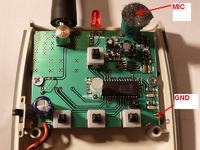Zedman
Full Member level 6

Please help me with this:
I made an RF audio TX device, it has a mic input digitizes the voice and sends it over 900 MHz to the RX device which than records it.
The problem is that the Mic is located close < 8cm to the Antenna and I get the 16ms (~60Hz) sending noise. It's approx a 1/3 ON and 2/3 OFF square wave.
It's for voice only and I need only the 300-4000Hz band.
I tried to build a 4th order bandpass filter, but it's useless for square waves.
I cannot place the Mic much further because it's a handheld device and the box is not as big.
As it's running on a dsPIC, should I use digital filtering?
Is it possible to eliminate this, how do they do it on GSM phones?
Any suggestions?
thanks,
Zedman
I made an RF audio TX device, it has a mic input digitizes the voice and sends it over 900 MHz to the RX device which than records it.
The problem is that the Mic is located close < 8cm to the Antenna and I get the 16ms (~60Hz) sending noise. It's approx a 1/3 ON and 2/3 OFF square wave.
It's for voice only and I need only the 300-4000Hz band.
I tried to build a 4th order bandpass filter, but it's useless for square waves.
I cannot place the Mic much further because it's a handheld device and the box is not as big.
As it's running on a dsPIC, should I use digital filtering?
Is it possible to eliminate this, how do they do it on GSM phones?
Any suggestions?
thanks,
Zedman




